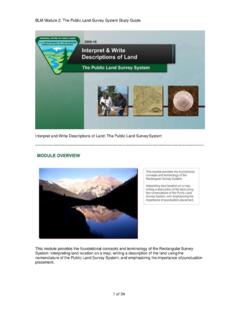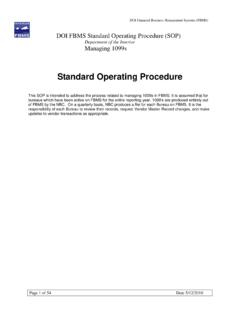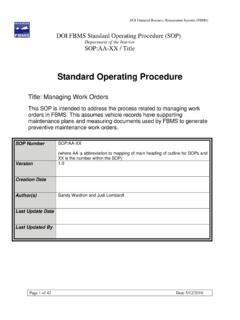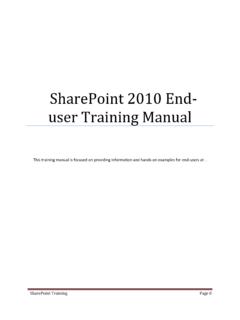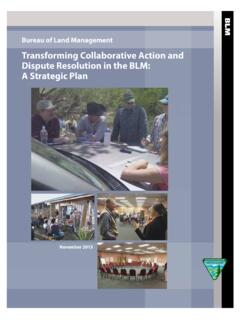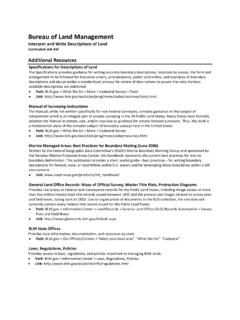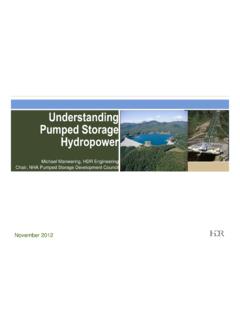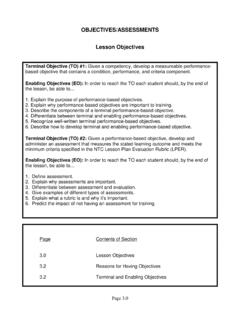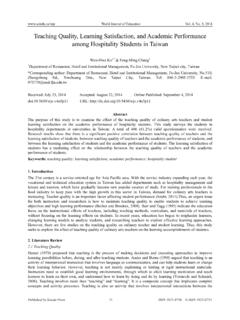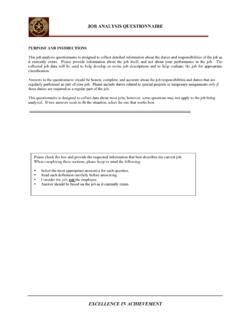Transcription of EFFECTIVE QUESTIONING TECHNIQUES
1 EFFECTIVE QUESTIONING TECHNIQUES Objectives Terminal Objective (TO): Given a case study involving a classroom question and answer segment, recognize instances where the instructor used/did not use EFFECTIVE QUESTIONING TECHNIQUES based on the types of questions covered in the lesson and the minimum criteria specified in the NTC Instructor Delivery Evaluation Checklist and Guidelines. Enabling Objectives (EO): In order to reach the TO each student should, by the end of the lesson, be able 1. Explain how EFFECTIVE QUESTIONING TECHNIQUES promote learning. 2. Differentiate between knowledge and comprehension type questions. 3. Explain why comprehension type questions are critical to assessment. 4. Recognize the different types of directed classroom questions. 5. Give examples of directed questions being used in the classroom.
2 6. Describe the different types of ineffective questions instructors should avoid. 7. Predict the impact of poor QUESTIONING TECHNIQUES on participant learning. Page Contents of Section Objective Bloom s Taxonomy Asking Questions What Questions Target Different Levels of Thinking? (From Bloom's Taxonomy) Ask questions that make people think at more than one level of thinking. Try these or similar action words in your questions. You can influence how people think! Many action words can cause thinking at more than one level. Notice also that not all questions need to be written in question form. Level 6: Evaluation Example: Why was the introduction ineffective? What are you recommendations for improvement? What is your justification?
3 Appraise Argue Assess Choose Conclude Criticize Critique Debate Decide Defend Dispute Judge Justify Rate Recommend Weigh Level 5: Synthesis Example: How could you have done it differently? Combine Compose Create Design Devise Develop Expand Hypothesize Imagine Invent Make up Modify Organize Plan Level 4: Analysis Example: Was that an EFFECTIVE introduction? Why or why not? Analyze Break down Categorize Compare Contrast Diagram Dissect Examine Investigate Map Scrutinize Separate Simplify Take apart Level 3: Application Example: What would be an EFFECTIVE introduction for a lesson on stress?
4 Apply Assemble Develop Compute Construct Demonstrate Dramatize Draw Illustrate Solve Test Work Out Level 2: Comprehension Examples: Why is it necessary to have a route in the intro? What might be an example route for a lesson on stress? What is the likely result of not having a route? Classify Describe Discuss Explain Generalize Give an example Outline Paraphrase Recap Rephrase Reproduce Sort Translate Predict Level 1: Knowledge Example: What are the required elements in an NTC introduction? Which element in an introduction serves to motivate? Find Identify Label List Locate Match Name Select State Tell Remember: With the exception of the Knowledge-Level, each level in Bloom s Taxonomy is dependent on the previous level.
5 For example, you cannot perform a task (application) unless you first know what needs to be done and comprehend how to do. Read each sample question and think about how it relates to that level. Higher Levels of Thinking Asking Questions I. EFFECTIVE Questions a. Lead-off questions. A lead off question is designed to stimulate thinking and generate discussion, and is phrased so students are aware of the main point. These types of questions are particularly useful during the guided discussion method where you want student input and discussion of the main point. For example, during a lesson on leadership enhances morale," you may have a main point such as, Leader s integrity enhances morale. You might lead off with the question: "How does a leader s integrity enhance morale?" This focuses students on the topic and gets them thinking.
6 This is how lead-off questions promote learning. b. Follow-up questions. Once you've gotten the discussion rolling with your lead-off question, you want to guide the discussion. You do this with follow-up questions. You should plan follow-up questions that will guide the lesson progression by supplying sub-ideas that will promote student reasoning. For example, after our lead-off question of "How does a leader s integrity enhance morale," you might follow-up with a sub-idea of leadership integrity -- and how it relates to morale, such as "How does your boss integrity enhance morale?" Well-planned follow-up questions promote learning by guiding the lesson's progression and promoting student reasoning. c. Spontaneous questions. (1) As your lesson progresses, you may notice students are getting off track.
7 Instead of focusing on leadership and morale, they may be discussing followership and morale, or leadership and mission accomplishment. In either case, you need to get them back to the point under discussion. You do this by using a spontaneous question. By the very nature of the term, you've probably already guessed you can't plan these! You have no way of knowing ahead of time someone is going to get off of the subject. What you need to do when it happens, though, is to ask a question that will bring the discussion back to the lesson, such as: "That's a very interesting point about the follower's integrity and morale, but let's focus on the leader's role for the moment. How does your boss integrity enhance morale?" You've given the student positive feedback ("interesting point") to ensure you don't shut him or her off, and then repeated the follow-up question to get him or her back on the subject.
8 (2) Another time you may need to use a spontaneous question is if the students aren't discussing the whole relationship of the lesson objective -- for example, leadership and morale. If they focus on only one aspect of the lesson, such as leadership, then you need to ask a spontaneous question to focus them on the rest of the point: "How does that [whatever leadership example he or she has given] enhance morale?" You've focused the student on the whole relationship and gotten him or her to think through how one affects the other. (3) Another example of when you would use a spontaneous question is if you need to seek clarification of a student's response. Let's say during the discussion, a student gives an answer that isn't really clear to you. Chances are, if it's not clear to you, it's probably not clear to the other students .
9 At that point, you could say to the student, "Would you restate that in another way?" or "Could you explain your answer in more detail?" This allows the student the chance to make himself (or herself) clear. Q: How would asking spontaneous questions promote learning? AR: - Keeps the discussion on track. - Ensures the inputs relate to the entire lesson. - Ensures clarity of responses. (4) Sure! Spontaneous questions promote learning by keeping students on the subject, ensuring their responses focus on the whole relationship of the lesson objective and ensuring student responses are clarified for everyone's benefit. d. Rhetorical questions. (1) When an instructor asks a question for which no response is required, it is a rhetorical question. Either the question goes unanswered or the instructor answers it himself (herself).
10 In this sense, rhetorical questions are self-directed since they are not directed to the students . (2) (Rhetorical question) Why would an instructor ask questions for which no answer is expected? Rhetorical questions are useful throughout the lesson, from the attention step that asks "Have you ever wondered why .. ?" to the hook that asks "How can you use this information?" to the summary that asks "What have we covered today? Rhetorical questions promote learning by focusing students on a new angle or by getting them ready for a new direction in the lesson. e. Direct questions. Direct questions are the ones most of us as students dreaded! These are the ones the teacher asked us -- by name! -to answer. But now that you're on the other side of the classroom, direct questions can help you in many ways.
